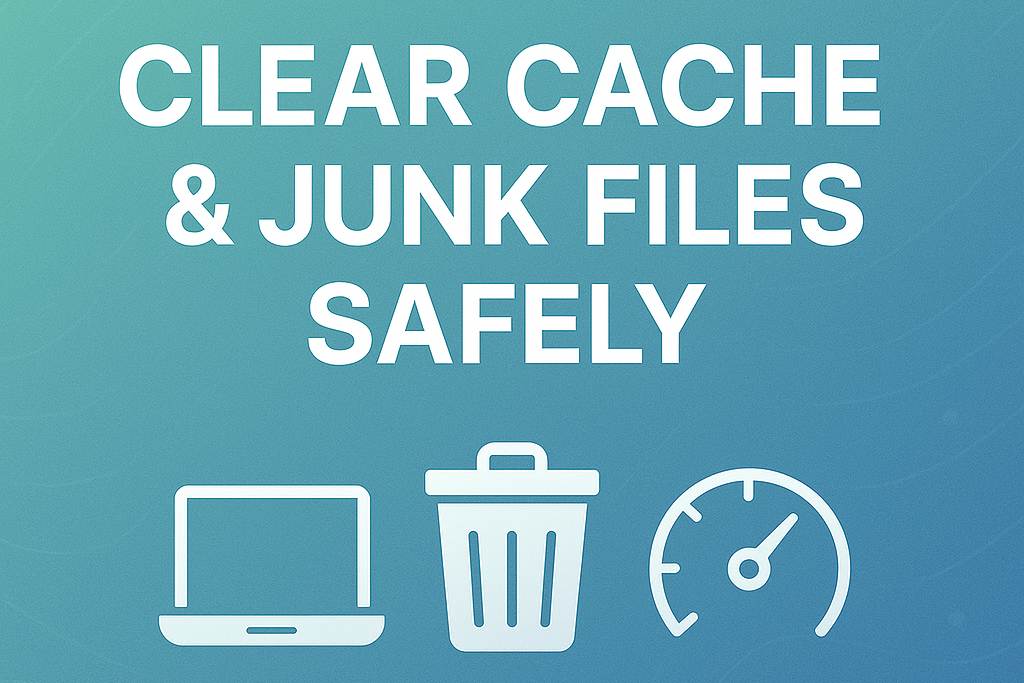Keeping your device free of cache and junk files is essential for maintaining speed, saving storage, and ensuring smooth performance. Knowing how to clear cache and junk files safely helps prevent unnecessary file buildup that can slow down your system or cause glitches. Here’s a step-by-step guide for Windows, macOS, and mobile devices.

Why Clearing Cache and Junk Files Matters
- Frees up valuable disk space
- Speeds up system and browser performance
- Loads updated versions of websites and apps
- Troubleshoots common glitches and errors
Clearing Cache and Junk Files on Windows
1. Clear Browser Cache
- Open your browser (Chrome, Edge, Firefox, etc.).
- Go to the menu and select “History.”
- Choose “Clear Browsing Data.”
- Select “Cached Images and Files” and set the time range to “All Time.”
- Click “Clear Data.” Restart the browser for best results.
2. Delete Temporary Files
- Open the Start menu, type
Disk Cleanup, and launch the tool. - Select your main drive (usually C:).
- Check “Temporary Files” and other categories you want to clean.
- Click “OK” to delete them.
3. Use Windows Disk Cleanup
- Right-click on your C: drive in File Explorer and select “Properties.”
- Click “Disk Cleanup,” then “Clean Up System Files.”
- Select all options for a thorough cleanup and click “OK”.
4. Manually Remove Temp Folders
- Press
Win + R, typetemp, and press Enter. Delete all files in the folder. - Repeat with
%temp%andprefetchcommands—delete contents but not the folders themselves.
5. Clear SoftwareDistribution Downloads
- Navigate to
C:\Windows\SoftwareDistribution\Download. - Delete all files inside (not the folder itself) to remove old Windows update files.
6. Empty the Recycle Bin
- Right-click the Recycle Bin and select “Empty Recycle Bin”.
7. Uninstall Unused Programs
- Go to Control Panel > Uninstall a Program.
- Remove software you no longer use to free up space.
Clearing Cache and Junk Files on macOS
1. Clear System Cache
- Open Finder and go to
~/Library/Caches. - Delete files inside folders you recognize (avoid deleting unknown folders).
2. Clear Browser Cache
- Open your browser and follow similar steps as on Windows to clear cached data.
3. Use Built-In Cleanup Tools
- Go to System Settings > General > Storage > Manage.
- Use “Reduce Clutter” and other options to optimize storage.
Clearing Cache and Junk Files on Mobile Devices
For Android:
- Go to Settings > Apps > [App Name] > Storage > Clear Cache.
For iOS:
- Go to Settings > General > iPhone Storage.
- Offload or delete unused apps and data.
Additional Tips for Safe Cleanup
- Backup Important Data: Before deleting large amounts of files, consider backing up your data in case you remove something important.
- Use Trusted Tools: Tools like Windows Disk Cleanup, Storage Sense (Windows 10/11), or reputable third-party cleaners (e.g., CCleaner) can automate the process safely.
- Be Cautious: Only delete files and folders you recognize, especially in system directories. Avoid deleting entire system folders.
Conclusion
Regularly clearing cache and junk files is a simple yet powerful way to keep your devices running smoothly. By following the steps above, you’ll reclaim storage, boost performance, and avoid common system issues—all while keeping your data safe. Make it a habit to clean up every few weeks for the best results!
